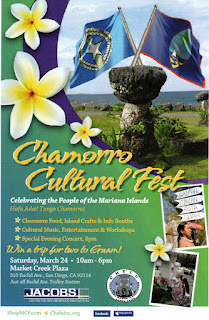This hymn, equally appropriate for either Lent (
Kuaresma) or for the Sorrowful Mother (
Dolorosa), is in the traditional Guam hymnal but is now forgotten. The people in Saipan have preserved it and sing it often. The recording is of the Kristo Rai choir in Garapan, Saipan from the 1990s and is taken from an old cassette tape, so pardon the glitches. Some of my notes and observations follow, but here are the lyrics :
Ma kana' gi Kilu'us, ma så'pet fehman Gue'.
(He was hung on the cross, He suffered intensely.)
I maolek na Nanå-ña, tumatacho' guihe;
(His good Mother stood upright there;)
ilek-ña sen pinite, "Nanå-ho ennaogue'
(He said mournfully, "My mother, there is)
si Juan fina' lahi-mo, kuentå-ko konne' gue'."
(John your foster son, my proxy, take him.")
Linachai minalaet, i sen Nånan Yu'us
(Consumed by bitterness, the true Mother of God)
gi mappot sumagå-ña, umafana' i dos
(in her difficult presence, the two of them faced each other)
ma klåba gi tres lulok, gi halom kilu'us
(He was nailed with three nails, on the cross)
i mames na Lahi-ña, i maolek as Jesus.
(her sweet Son, the good Jesus.)
Umågang i Saina-ta, ilek-ña "Må'ho yo'."
(Our Lord cried out, saying "I thirst.")
I taihanom na Nåna, yinengyong takkalom
(the waterless Mother, shook intensely within)
mamichao gi matå-ña, dos lågo' dångkulo
(gushing from her eyes, two large tears)
ya ayo ha atue, i må'ho na påtgon.
(and that is what she offered, her thirsty child.)
O Bithen mipinite, ma'åse' pulan ham
(O Virgin full of sorrow, kindly watch over us)
taiguihe as Jesus-mo, annai un pupulan
(as you did your Jesus, when you watched over Him)
gef hasso i fino'-ña, na un gofli'e' ham
(remember well His words, that you would love us)
fa' Nånan-måme, Nåna, ya gef adahe ham.
(make yourself, Mother, our Mother, and protect us well.)
NOTES
Nåna. There is perhaps no stronger or more evocative word in Chamorro as the word
Nåna. Mother is source of life, sustainer, protector, provider, abundant font of love. She always loves, always gives, always sacrifices. So Chamorro women see in Mary an image of themselves, suffering for (and sometimes on account of) their husbands and children, or for single women, for their families. Men see in Mary a replica of their earthly mothers, to whom they can run in time of trouble.
Fehman. Rarely heard today. It means "strongly, seriously, intensely."
Nihi ta fanmanåyuyut fehmaman! Let us fervently pray!
Fina' lahi-mo.
Fa' means "to make." Thus it connotes that the "thing made" is not original; we made it so.
Fina' denne' is
donne' (chili pepper) made into something.
Fina' lahe is someone not your son (
låhe) who has been made your son. Look at the last stanza, as well.
Fa' Nånan-mame. "Make yourself our Mother." Saint John the Beloved Disciple was given Mary to care for as his mother now that her only son Jesus would die; Mary became John's mother and ours as well.
Kuenta. Borrowed from the Spanish
cuenta. It means a "substitute, representative, proxy."
Hånao kuentå-ko. "Go as my representative."
I taihanom na Nåna. Perhaps the most gut-wrenching part of this hymn : a mother who is unable to relieve the sufferings of her son. She is powerless, so she does the little she can. She gives her son her tears to drink.
Mamichao. Rooted in the word
petchao, which means "to dart, spurt."























